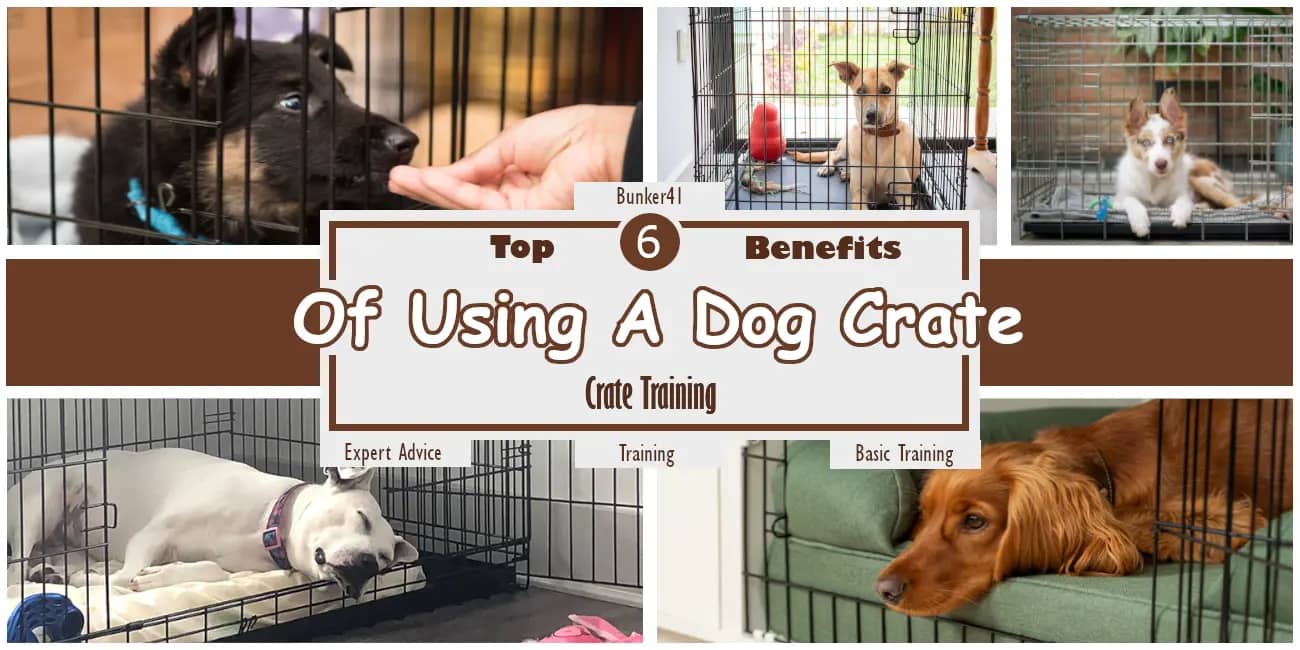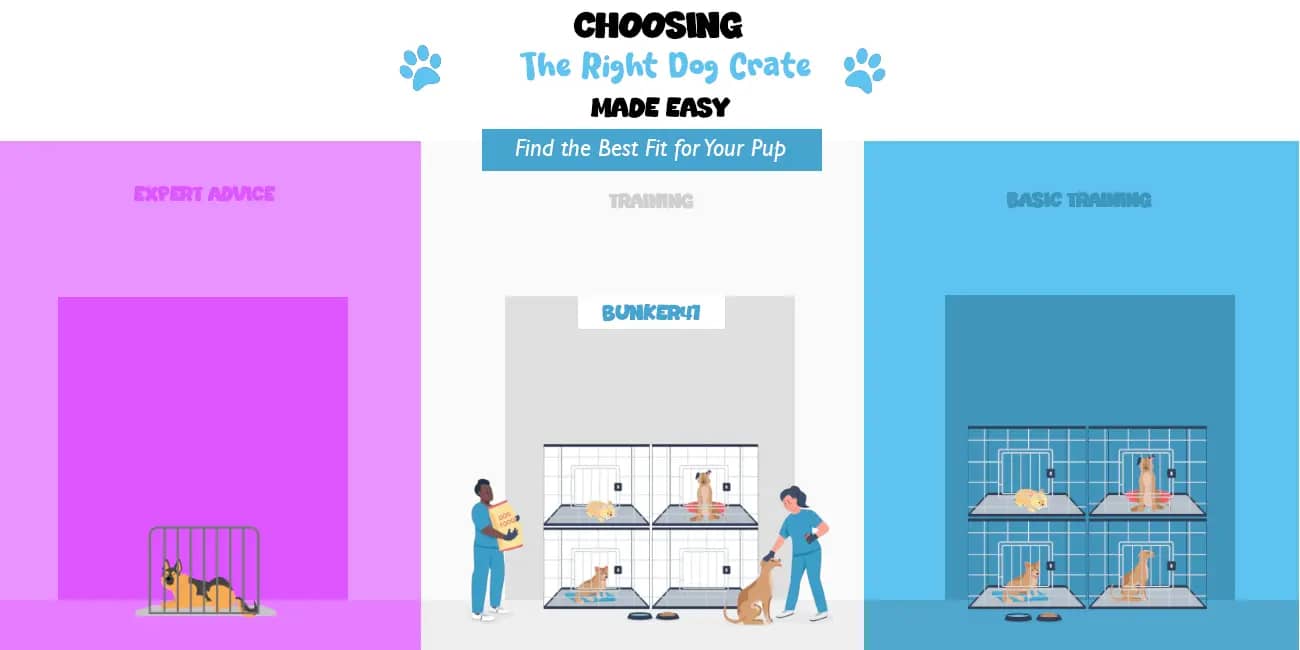Your cart is currently empty!

Top 6 Benefits Of Using A Dog Crate – 2025 Crate Training Benefits
Introduction
“The art of dog training is understanding their world through compassion and structure.”

Crate training has truly changed the way we raise our dogs—and in 2025, it’s more popular and beneficial than ever. For many pet parents, introducing a dog crate into the daily routine has proven to be a total game-changer. It’s not just about putting your pup in a box. It’s about creating a safe space that your dog actually wants to be in. Whether you’re crate training a puppy who’s learning the ropes of house rules or helping an adult dog stay calm during vet visits, the benefits of crate training run deep. A crate-trained
dog sees their crate as their own little den—a cozy, peaceful spot where they can sleep, relax, and feel secure. It’s a great way to help them cope with separation anxiety, prevent them from getting into dangerous items like electrical cords, and manage stress when the environment gets overwhelming. It also helps prevent bad habits like chewing, barking, or potty accidents, especially in young dogs with limited bladder control. Think of it as one of the most effective tools to properly train your dog from a
young age, and to keep them safe when you can’t supervise. Crate training is also a lifesaver for house training. Dogs learn quickly not to go potty in their sleeping area, so with the right timing and regular potty breaks, you can house train your pup with fewer accidents and less mess. Crates are also ideal for maintaining routine and rest, giving dogs a reliable place to sleep and relax after training sessions or playtime with other dogs. And let’s be real: many dogs just feel more comfortable when they have a space to call their own. Whether it’s a quiet spot to nap during a loud gathering or a cozy nook to stay in while you leave for errands, a dog’s
crate provides comfort, structure, and peace of mind for both you and your furry friend. With the right size crate, you’re not just giving your dog a place to stay; you’re giving them the gift of security, comfort, and greater peace in an often chaotic world. So, if you’ve ever wondered whether crate training is worth the effort, the answer is a definite yes. From potty training to managing crate rest after surgery, the benefits of using a dog crate go far beyond the basics. In this blog, we’ll explore six powerful reasons why every dog owner should consider crate training their dog in 2025. Whether you’re working with a brand new puppy, a recently
adopted rescue, or simply trying to improve life with your current pup, these crate training benefits can help you create a more peaceful, well-structured home for both you and your dog.
Key Takeaways
Top 6 Benefits Of Using A Dog Crate

hen it comes to taking care of your dog, comfort, safety, and structure go hand in hand—and that’s exactly where crate training shines. These days, more pet parents are discovering that a dog’s crate is more than just a training tool—it’s a safe space, a cozy retreat, and a powerful way to raise a happier, healthier pup. Whether you’re working with a rambunctious puppy or helping adult dogs feel more secure, the benefits of using a dog crate cover everything from house training and potty breaks to easing separation anxiety and reducing barking, chewing, and other bad habits caused by free roaming. In fact, experts and vets alike
often recommend crate training as an essential part of raising a well-behaved dog. With the right size crate, you’ll be helping your pup feel safe and confident during vet visits, recovery from health issues (hello, crate rest), or even when they just need a break from the chaos of the entire house. Crates support structure, routine, and rest, making them ideal for training sessions, bedtime, or anytime your dog is feeling stressed. They’re also one of the fastest ways to properly train and house train dogs, especially those at a young age or with limited bladder control. So, if you’ve been on the fence about whether to crate train your
dog, consider this your sign. There are many benefits to using dog crates, and they’re not just for keeping your pup in one place. Today, we’re diving into the top 6 crate training benefits every dog owner should know in 2025. From improving behavior to offering true peace of mind for both you and your dog, this guide has everything you need to make your crate trained dog feel safe, secure, and totally at home.
Benefit 1: Creating a Safe Haven for Your Dog

Dogs are wired by nature to seek out small, secure spaces where they can unwind and feel protected—it’s part of their instinctive behavior passed down from their wild ancestors. That’s why introducing a crate can be one of the most comforting and effective choices you make as a pet parent. A dog’s crate mimics the cozy, den-like environments dogs are drawn to, providing a safe space where they can escape the noise, avoid feeling stressed, and simply rest or sleep without worry. For many dogs,
especially puppies or those with separation anxiety, a crate becomes their personal retreat—a place to remain calm, stay out of trouble, and avoid dangerous items like electrical cords while unsupervised. By crate training your dog, you’re doing more than just teaching them to stay in one spot. You’re tapping into their natural instincts and giving them a safe place to sleep, relax, and recover—especially during vet visits, illness, or crate rest after surgery. It also helps with potty training, as crate trained dogs typically avoid going where they sleep, leading to
faster house training with fewer accidents. Over time, your pup learns to associate the crate with peace, comfort, and routine, making it a go-to zone when they need a break from the entire house, other pets, or just life in general. Crates are also a smart way to properly train your dog from a young age, helping to prevent bad habits like excessive barking, destructive chewing, or free roaming when you leave them alone. With the right size crate, your dog will feel secure—not confined. That’s why vets and trainers often recommend crate training as an essential part of raising a well-adjusted pup. Simply put, the benefits of using a dog crate
go beyond convenience—they’re rooted in understanding your dog’s instincts and giving them a space that works for both you and your furry companion.
Understanding Your Dog’s Natural Shelter Instincts
Wild canines seek small, enclosed spaces for protection. By giving your dog a crate, you meet a deep psychological need. Here’s why a crate is essential:
For rescue dogs or anxious pets, a well-designed crate can be transformative. It’s more than a physical space. It’s an emotional sanctuary where your dog can decompress and feel safe.
“A crate is not a cage, but a safe haven that speaks to a dog’s deepest instincts for security and comfort.”
Introduce the crate gradually and positively. Make it inviting with soft bedding, favorite toys, and treats. Your goal is to make your dog see their crate as the safest place in the world.
Benefit 2: Aiding in House Training and Routine Establishment
Crate training is a great way for dog owners to help with house training. It uses your dog’s natural instincts to teach them to go potty outside. This method works well for both puppies and adult dogs. Dogs naturally want to keep their sleeping area clean. This makes crate training a smart choice for teaching them to control their bladder and bowels. A consistent crate training routine offers many benefits:
Expediting the Potty Training Process
House training needs regular potty breaks and a set schedule. Your crate is a key tool in this process. By watching your dog’s crate time and giving them outdoor breaks, you can make potty training faster. Here are some potty break guidelines:
Being patient and consistent is key to crate training. Praise your dog for going potty outside. This helps them associate going outside with good behavior. Every dog learns at their own pace, so be patient and supportive during house training.
Benefit 3: Ensuring Safety During Your Absence

Let’s be honest—leaving dogs alone at home can be a little nerve-racking. As much as we love them, unsupervised pups can get into all sorts of trouble, especially when they have free access to the entire house. That’s where crate training becomes a total game changer. A crate trained dog knows their crate isn’t a punishment—it’s their personal safe space, a cozy and secure place where they can stay dog safe while you’re away at work, running errands, or even during an overnight trip. For pet
parents, this means greater peace of mind, knowing your dog isn’t chewing through electrical cords, knocking over cleaning supplies, or swallowing small dangerous items that could lead to choking or a trip to the vet. When you crate train your dog from a young age, you’re helping them build positive habits that prevent risky behavior during alone time. Many of these problems—like chewing, barking, or inappropriate potty breaks—stem from stress, boredom, or having too much space to roam unsupervised. Dog crates limit that
free roaming, giving your dog clear boundaries and a sense of structure. Not to mention, it keeps them out of rooms where they shouldn’t be in the first place. It’s especially helpful for puppies, who are still learning the house rules, and adult dogs with a history of bad habits or separation anxiety. Whether you’re stepping out for a few hours or need to keep your dog safely contained during recovery after surgery (crate rest), having the right size crate in place ensures your dog stays out of harm’s way. With the proper setup and training, your pup can rest, relax, and even sleep peacefully in their crate—no stress, no mess.
This is one of the biggest benefits of using a dog crate, and one of the reasons so many vets and trainers recommend crate training as a smart, safe, and long-term solution for both you and your dog.
Protecting Your Dog from Household Risks
Young puppies and new dogs are very vulnerable. They don’t know the house rules and can easily get into trouble. A crate gives your dog a safe, controlled space. It keeps them safe from accidents.
A well-designed crate is more than a containment area – it’s a safe haven that gives you peace of mind.
By using crate training, you’re not just saving your home. You’re also making a safe space for your dog when you can’t watch them. This keeps them safe from unexpected dangers.
Benefit 4: Easing Anxiety and Behavioral Management
Crate training is a great way to help your dog feel better emotionally. Dogs can get anxious and stressed when left alone. But, a well-made crate can be their cozy, safe spot. Teaching your dog to use a crate helps them learn to manage their feelings. It creates a safe area for them. This helps solve many behavioral problems:
Transforming Stress into Comfort
A crate can become more than just a small space. It becomes a place where your dog can relax and feel safe. Dogs naturally seek den-like environments when feeling overwhelmed. A crate meets this need perfectly. Veterinary behaviorists say crate training can really help with anxiety. It teaches your dog to handle their emotions better. A routine and a safe space are key.
“A crate is not a punishment, but a tool for emotional support and behavioral development.”
Being patient and using positive methods is important. Help your dog see the crate as a good place. Start slow and make it a positive experience for them.
Benefit 5: Facilitating Veterinary Care and Travel

Let’s face it—vet visits and travel can be stressful, even for the chillest pups. But here’s where crate training really proves its value. When your dog already sees their crate as a safe space, that same crate becomes a comfort zone during high-stress situations like road trips, airport transfers, or overnight vet stays. A crate trained dog is far more likely to remain calm in unfamiliar environments because they’ve already associated their dog’s crate with peace, routine, and relaxation—not panic.
For pet parents, this means less anxiety, fewer meltdowns, and safer handling during transport or care. Vets and trainers often recommend crate training well before any potential medical issues arise. That’s because if your dog ever needs crate rest due to health issues or post-surgery recovery, it won’t be a foreign or frightening experience. They’ll already know how to settle in and rest, making healing quicker and less stressful. And when it comes to traveling, having a crate trained dog makes the whole experience smoother for both you and your pup—especially
during long car rides, overnight boarding, or crowded situations involving other dogs. The crate keeps your dog safe, contained, and protected from dangerous items, sudden movements, or unpredictable environments. Plus, with the right size crate, your dog has enough room to sleep, turn around, and spend time comfortably, which is especially helpful when you need to leave dogs for a short time or when staying in places where free roaming isn’t an option. It’s another one of the many benefits of using a dog crate that extends beyond basic house training and into real-life, practical situations that matter most. Whether
it’s a quick trip to the vet or a week-long vacation, crate training your dog is one of the smartest ways to make transitions smoother, safer, and far less stressful for everyone involved.
Managing Medical Challenges with Crate Training
Vets like dogs that are okay in small spaces. A well-trained dog is less stressed during vet visits. This is true for:
Travel Safety and Comfort
Crate training gets your dog ready for travel. It keeps them safe and calm, whether it’s a short drive or a long trip. A familiar kennel offers security.
| Travel Scenario | Crate Benefits |
|---|---|
| Car Travel | Prevents distracted driving, protects dog from sudden stops |
| Air Travel | Meets airline safety requirements, reduces travel anxiety |
| Overnight Stays | Provides consistent, comfortable environment |
Spending time on crate training is worth it. It turns a crate into a tool for your dog’s health, safety, and happiness in many situations.
Benefit 6: Flexibility for Dogs of All Ages and Sizes

One of the best crate training benefits is how flexible and adaptable it is—crate training truly works for dogs at any life stage, whether you’ve got a tiny new puppy, an energetic adolescent, or a mellow adult dog. That’s the beauty of it: no matter your dog’s age, breed, or personality, there’s a crate out there that fits just right. The key is choosing the right size crate—one that gives your pup enough space to sleep, stretch out, and turn around comfortably, without being so big they lose that cozy,
safe space feeling. A well-fitted crate offers both comfort and security, making it easier to crate train your dog no matter where they are in their journey. For puppies, crates are incredibly useful for house training, managing potty breaks, and helping them learn house rules while also preventing chewing or getting into dangerous items like electrical cords. Since they have limited bladder control, having a crate helps teach them to wait for the right time for a potty break—an essential part of properly training young dogs. As they grow, you can
upsize the crate or use adjustable dividers to give them more room. Meanwhile, for adult dogs or even senior pups, dog crate training is equally valuable. It offers a calm retreat when they’re feeling stressed, a safe place during travel or vet visits, or even a necessary confinement option during crate rest after health issues or surgery. Many pet parents also use crates as a way to keep older dogs from overexerting themselves or when they need to stay overnight somewhere new. With the right crate, your dog can spend time safely no matter their age or energy level. From training sessions and barking control to
offering peace of mind when you have to leave dogs home alone, the benefits of using a dog crate scale with your dog’s needs. It’s not just for new pups or anxious rescues—it’s an essential part of life with many dogs, providing structure, safety, and that comforting sense of routine that all dogs crave.
Matching Crates to Different Life Stages
Dogs at different life stages need different crate training:
Crate Size Selection Guide
| Puppy Age | Crate Considerations |
| 8-12 weeks | Use divider, minimize space |
| 3-6 months | Adjust divider, increase space |
| 6-12 months | Prepare for adult dog size |
Choosing the right size crate is crucial. It should let your dog stand, turn, and lie down easily. Measure your dog carefully to find the perfect fit for their body shape and size. Remember, crate training is flexible. Your approach should change as your dog grows and changes. This way, you create a safe, consistent space that meets their evolving needs.
Crate Training Tips: Ensuring Comfort and Safety

Creating a Positive Crate Experience
To train your dog well, follow these important steps:
Make the crate a welcoming place during training. Comfort is essential for crate training success. Add soft bedding, familiar blankets, and fun toys to make your dog feel safe.
Practical Training Techniques
Positive reinforcement makes crate training work. Start with short crate times and watch your dog’s comfort. Gradually increase the time as they get used to it.
Every dog is different, and patience is key. A consistent, gentle approach will help your dog love their crate. This builds a positive bond with their personal space.
Conclusion: Why Experts Recommend Crate Training

Crate training is key for dog owners, helping manage behavior and safety. Vets and dog trainers say it’s good for your dog’s mind and body. It’s a way to keep your dog happy and safe. Using crate training, you make a safe space for your dog. It helps them feel secure and learn good habits. This training is worth it, making life easier for both you and your dog. With patience and positive feedback, crate training does more than just manage behavior. It builds trust and better communication with your dog. Experts say a crate can be a place of comfort, reducing stress and making vet visits easier. Choosing crate training shows you
care about your dog’s happiness. It means you’re committed to a safe, loving home for them. It helps them feel secure and understand what’s expected.
Summary
Crate training isn’t just a popular trend among pet parents—it’s a proven, practical way to help your dog feel safe, secure, and well-adjusted. From offering a safe space that reduces stress to reinforcing good behavior and easing house training, a crate can quickly become a trusted tool in your training toolkit. Dogs that are crate trained not only learn to follow house rules more easily, but they also tend to have fewer behavior issues like chewing, barking, or struggling with separation anxiety. Whether you’re raising a rambunctious puppy or working with an adult dog, crates promote routine, keep your pet safe from dangerous
items, and help you manage your time away without worry. What’s more, crates are incredibly helpful for vet visits, travel, and recovery from illness or injury. With the right size crate, proper training, and a little patience, you’ll unlock all the benefits of crate training—for both your dog and yourself. Bottom line? Crate training offers structure, safety, and peace of mind. And for many dogs, it becomes their favorite place to relax, sleep, and just be a dog.
FAQ
Articles Related To The Topic
Futher Resources For More Reading
Follow Us
Related Articles
Gallery
Site Built By Kadence
Copyright@2025 Bunker41 – All Rights Reserved













